Dental implants are an increasingly popular way to replace missing teeth, and consist of a titanium post that is inserted into the jawbone and which is used to support the replacement tooth.
Traditionally, the implant is left to heal for several months before being loaded with the implant crown, bridge or denture.
Nowadays immediate loading is becoming far more common, where the implants and temporary teeth are placed within 48 hours of implant surgery and are left in position for the healing period. At the end of the healing period, the temporary teeth are replaced with permanent crowns.
In This Guide
- Definition of Immediate Loading
- How They Work
- The Procedure
- Benefits, Risks and Alternatives
- Who is a Candidate
- Success Rates
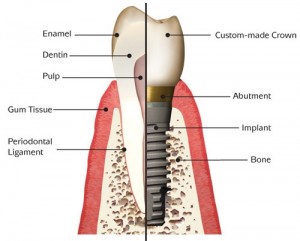
What Does ‘Immediate Loading’ Mean?
This is where a temporary crown is attached to the dental implant soon after it has been inserted into the jawbone. This replacement tooth is usually carefully shaped so it does not come into contact with the tooth on the opposite side of the mouth and is merely for cosmetic purposes.
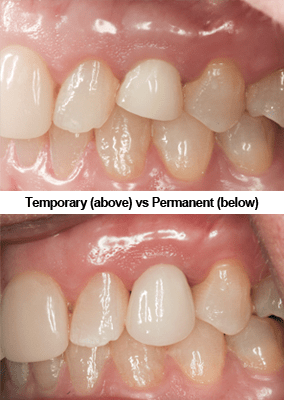
Immediately loaded implants can also be functional, meaning they will come into contact with the opposing teeth and can be used for eating. These “immediate functionally loaded” dental implants tend to be used when several of them are in a row at the front of the mouth and are joined by a rigid connector such as a denture.
A common example of this is an “all-on-4” lower denture, as this technique locks all the implants together so they are held rigidly within the jawbone as it heals. This way, any forces applied that might cause a single implant to fail are distributed among several implants.
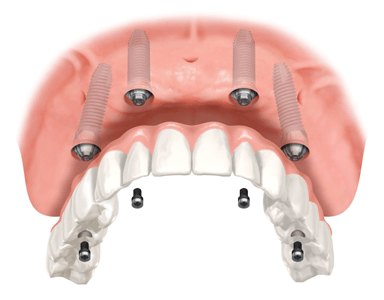
Either way, the patient benefits from having natural looking teeth while the implants fuse with the bone. While this might sound very appealing, it is worth weighing up the benefits and potential risks of immediate loading compared to traditional methods of implant placement (outlined below), as this technique is not suitable for everyone.
The concept of immediate loading isn’t new, as it has been used since the 1960s when modern dental implantology was still in its early stages. However, advances in imaging technologies have made it much more successful.
How Do They Work?
The use of computed tomography (CT scans) enables dentists to precisely place implants in the jawbone. Special torque wrenches measure the amount of torque put on the implants during placement. These technologies make it possible to place the implants under ideal conditions in the correct amount of healthy bone.
The healing period is just as important as it is for traditional implants as it still takes months for the process of osseointegration to take place. Osseointegration is the process where new bone tissue in the jawbone grows on and around the implant post, forming a direct connection and holding it firmly in position.
Studies have shown it is vital that the implants are not disturbed during osseointegration as even micro-movements could cause problems with the bond between the post and the bone, and that eliminating this movement is integral to the success of same day dental implants. This may be done through splinting multiple implants together, or by making sure the replacement teeth on single implants do not bite against the teeth in the opposing jaw.
Although it is important to prevent any movement in the dental implant post during the healing period, some research has shown that loading or placing some force on the implant may be beneficial as it promotes the growth of new bone cells around the implant post, but these stresses must be within strict parameters for the implant to be successful.
What is the Procedure?
Consultation and Diagnostic Tests
All types of dental implant surgery have to be meticulously planned, and this procedure begins with the initial consultation with the dentist you’ve chosen (here’s how to find one you can trust). They will need to know your complete dental and medical history before carrying out various diagnostic tests.
These tests include photographs, dental x-rays and a CT scan. The data from these tests must be analyzed as it is vital to assess the quality of the bone that will be surrounding the dental implants. Some dentists now offer patients the opportunity to view photographs of their mouth which can provide a better understanding of the proposed treatments.
There must be sufficient bone to make sure the implant post is properly supported, and to ensure the replacement tooth looks natural. If there isn’t enough bone then it can often be built up with a bone graft prior to the implant being placed. There should also be enough gum tissue to surround the implant and crown as this will affect aesthetics; you want your implant crown to look as if it is emerging naturally from the gums.
Gum tissue can be grafted from another site in the mouth if necessary. At this stage your dentist will also determine the best position for the implant, and will choose the correct size.
Once your dentist has all this information then they can begin planning the surgery. They will make a special surgical guide for use during surgery which pinpoints the exact area for the implant insertion.
Surgery
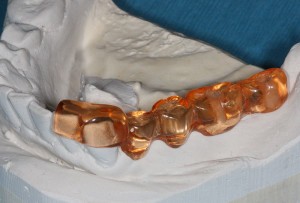 To help the surgeon position the implants a guide is made (usually out of acrylic) to show the desired position and angulation of the implants (see image).
To help the surgeon position the implants a guide is made (usually out of acrylic) to show the desired position and angulation of the implants (see image).
Your surgeon will insert the implant post directly into the jawbone using this surgical guide. The actual surgery to insert the post is quite quick and can often be carried out under a local anesthetic. If you require several dental implants or are particularly nervous then it is worth asking about extra sedation.
Your replacement tooth or teeth will be attached to the dental implant soon after surgery is completed.
Benefits and Risks of Same Day Dental Implants
Benefits
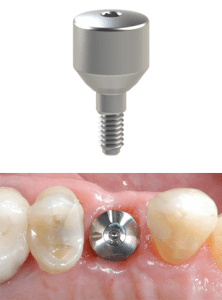 The healing cap “shapes” the soft tissue surrounding the implant, preparing the site for the permanent crown.
The healing cap “shapes” the soft tissue surrounding the implant, preparing the site for the permanent crown.
Reduced treatment time.
Able to replace a front tooth almost immediately. Traditional implants often take between three and six months to completely restore. As a result, many people will opt for faster but less effective methods of tooth replacement such as a dental bridge, and will miss out on the advantages offered by dental implants including preserving jawbone density.
Only one surgical procedure is required.
The implant, abutment and temporary crown are placed during the same procedure, greatly reducing overall treatment time. There is no need to uncover the implant 3-6 months later in order to add the abutment and crown.
Gum tissue matches up with the crown better.
Traditionally, cylindrical healing caps (see right) may be placed on top of the newly inserted dental implants to shape the gum tissue. With immediate loading, the gum tissue can be shaped by the temporary crown (which is more similar in shape to the permanent crown) so the gum tissue matches the permanent crown and better aesthetic results are achieved.
Avoid temporary dentures or the “missing teeth” look.
Immediate load dental implants reduce the psychological and physical impact of losing teeth by quickly replacing them so there is no need to wear a removable prosthesis such as a denture or have gaps in your smile during the healing period.
Risks
Even the smallest movement increases the risk of failure.
Immediate loading is a very precise technique and the surgeon does need to take precautions to ensure the implant cannot move while integrating with the bone.
The technique is only suitable in specific situations.
The implant has to be placed in strong bone and must be able to withstand 35 Ncm of torque. It works best for front teeth that have strong, healthy teeth on both sides. It is also successful for replacing all the teeth in the lower jaw where the bone is strong and dense.
Immediate loading does not work well for replacing all teeth in the upper jaw as the bone tends to be less dense and is rarely strong enough.
All implant surgery carries a small percentage of risk.
There are a number of factors that can cause problems. Implant failure can occur in the short-term if the implant fails to integrate with the jawbone or the surrounding gum tissue becomes infected. The risk of infection remains in the longer term, and there is always the possibility of mechanical failure if the implant is subjected to excessive stress or force.
Alternatives
It is important to take good care of the area around the implant for the first couple of months after the surgery in order to prevent infection and to make sure the implant isn’t exposed to too much force or pressure.
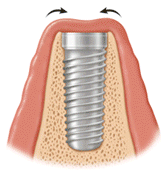 If maintaining this level of care could be a problem, then you should consider traditional dental implants that use a two stage technique.
If maintaining this level of care could be a problem, then you should consider traditional dental implants that use a two stage technique.
First, the implant is placed in the jawbone and allowed to heal for several months during this time it is covered and protected from the elements by gum tissue. A second surgery is then required to uncover the implant and attach the abutment and crown.
Alternatives of same day implants that also have short treatment times but are more affordable include partial dentures and fixed bridges.
Who is a Candidate?
The screening process is extremely thorough. The ideal candidate is someone who is in good dental and general health. You may not be suitable for treatment if you smoke, have any conditions that affect your immune system or reduce the body’s ability to heal, or if you have been prescribed high doses of bisphosphonate drugs.
This is because these drugs increase the risk of bone death after even minor surgery, particularly if they have been given intravenously as part of therapy for cancer. People who have been given low doses of bisphosphonates, for example for osteoporosis, are not at any higher risk for bone death.
Bruxism or teeth grinding and clenching can also negatively affect dental implants, through placing too much stress on the implant crown and post.
Patients who choose dental implants must be committed to good oral hygiene, as otherwise there is a chance the tissue surrounding the post could become infected with a condition similar to gum disease, and which is called peri-implantitis. This condition can result in implant failure if not promptly treated.
Same Day vs Early vs Delayed Loading – Success Rates
Once an implant is placed, it is important that new bone cells grow on and around the implant post so it bonds with the jawbone and is held firmly and permanently in position. It was previously thought that loading the implant during this healing period would increase the chances of failure, and that the implant post needed to be left to heal for between three and six months to ensure long-term success.
However more recent research has found the initial stability of the post is more important in determining the success of the implant. The initial stability is determined by the density of the bone, the force applied to place the implant and the number of implants that are splinted together. The conclusion of this research is that there is no significant difference between the successes of implants that are loaded immediately compared to those left to heal for several months.
That said, single dental implants should be given a period of no-load, to minimize the risk of micro-movement and failure. This is why immediate loading for a single implant is often only offered for front teeth – the temporary crown can be kept completely out of contact with other teeth during the healing period.
Conclusion
Same day dental implants can be useful in specific situations, but patients need to be carefully evaluated for their suitability. It is also important that the implant surgeon has sufficient skills and experience to accurately place the dental implants so the risk of any micro-movements is eliminated.
If you are not suitable for immediate load dental implants, it is still worth considering delayed loading implants, even though treatment will take a little longer.
What is the best price for immediate implant and ordinary implant of 14 tooth (with pooling the tooth out)?